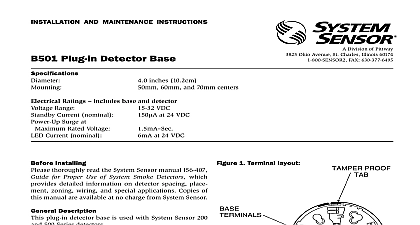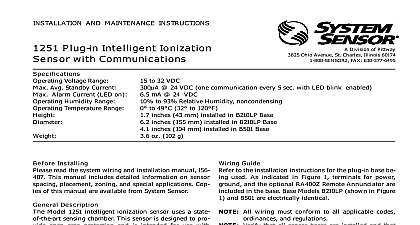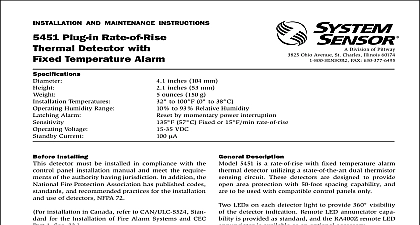System Sensor b501bh Install and Maint Instructions

File Preview
Click below to download for free
Click below to download for free
File Data
| Name | system-sensor-b501bh-install-and-maint-instructions-0285347961.pdf |
|---|---|
| Type | |
| Size | 622.89 KB |
| Downloads |
Text Preview
SYsTEM SENSOR Division of Pittway 3825 Ohio Avenue St Charles Illinois 60174 FAX 630 377 6495 AND MAINTENANCE INSTRUCTIONS Sounder Base inches 15.2 cm inches 5.9 cm lb 187 gm to 120 F 0 to 49 C to 95 Relative Humidity Diameter Height less sensor Temperature Range Humidity Range Ratings Supply Voltage to 32 VDC Current mA maximum Current mA maximum Ripple Voltage of supply voltage Capacitance Loop Supply Draw from Remote Output Sensor to turn on Horn Output maximum than 90 dBA measured in anechoic room at 10 feet 24 volts 85 dBA minimum in UL reverberant room Installing read System Sensor Manual I56 407 XX Guide for Use of System Smoke Detectors which provides de information on sensor spacing placement zoning and special applications Copies of this manual are at no charge from System Sensor NFPA 72 and guidelines should be observed sounder base is intended for use with intelligent sys Refer to the panel manual for the maximum allow number of units per loop The sounder base requires external 24VDC supply with reverse polarity capability connections for the external supply terminals 1 and 2 the communication loop terminals 3 4 and 5 are iso to prevent electrical interaction between them This manual should be left with the owner user this equipment The detector used with this base must be and maintained regularly following NFPA 72 require The detector should be cleaned at least once a year Description B501BH sounder base is used with System Sensor 200 500 Series sensor heads Refer to the appropriate for more information on sensors the sensor visible LEDs are latched on for approxi 10 seconds the associated horn sounds A loop of can be made to sound by reversing the polarity of the supply When not used as a supplementary evacuation sys the external 24 VDC supply shall be treated as component of the main power supply system and fall under the requirements of the main supply system per NFPA 72 Manuals Online Supply Positive Supply Negative Comm Line In Comm Line In and Out Comm Line Out Terminals 3 4 and 5 are used for the communication the B501BH directly to an electrical box using the kit supplied see Figure 2 sounder base is 1.1 inches deep Electrical boxes must 4 inches square by at least 1 1 2 inches deep 2 1 8 is recommended A maximum space of 1 8 inch from the outside of the electrical box to the inside edge of the or ceiling tile is allowable Guidelines wiring must be installed in compliance with the Na Electrical Code and the local codes having jurisdic and must not be of such length or wire size which cause the base to operate outside of its published The conductors used to connect smoke sen to control panels and accessory devices should be coded to reduce the likelihood of wiring errors Im connections can prevent a system from responding in the event of a fire signal wiring the wiring between interconnected sen or modules it is recommended that the wire be no than 18 gauge 1.0 square mm Wire sizes up to 12 2.5 square mm may be used with the base For best performance the power and wires and the circuit wires should be twisted pair or cable installed in separate grounded conduit to the communication loop from electrical interfer wire connections by stripping about 3 8 of insulation the end of the wire Then slide the bare end of the under the clamping plate and tighten the clamping screw Do NOT loop the wire under the clamping See Figure 3 zone wiring of the sensor base should be checked be the sensor heads are installed Check the wiring for and polarity in the base Manuals Online 1 Terminal layout 2 Mounting B501BH ELECTRICAL BOX INCH SQUARE BOX 3 THIS the individual sensor manual for the maximum sensor temperature Instructions External supply shown in normal standby configu in Figure 4 wiring diagram for a typical 2 wire intelligent system is in Figure 4 the monitor module is supervising the supply Before testing notify the proper authorities that smoke sensor system is undergoing mainte and therefore will be temporarily out of Disable the system undergoing mainte to prevent unwanted alarms and bases must be tested after installation and as integral part of periodic maintenance Test the B501BH follows Reverse the polarity of the external 24VDC supply All bases on the loop should sound in approximately seconds Latch the sensor LED on from the control panel That B501BH should sound in approximately 10 seconds There is approximately a 10 second delay built into the before sounding This delay is present whether control signal comes from the sensor or from the ex power supply polarity being reversed During automatic testing cycles the horn may sound if associated sensor is left in the test mode with LEDs on for more than 4 seconds Therefore it is nec to complete testing of each sensor within this 4 limit to prevent the horn from sounding 4 Wiring diagram A OPTIONAL WIRING COMM COMM POWER POWER A OPTIONAL WIRING Manuals Online 2 1 Limitations of Property Protection Smoke Detectors smoke detector is designed to activate and initiate emergency ac but will do so only when it is used in conjunction with an authorized alarm system This detector must be installed in accordance with standard 72 For installation in Canada refer to CAN ULC S524 Standard for the Installation of Fire Alarm Systems and CEC Part 1 32 detectors will not work without power AC or DC powered detectors will not work if the power supply is cut off detectors will not sense fires which start where smoke does not the detectors Smoldering fires typically do not generate a lot of which is needed to drive the smoke up to the ceiling where the detector is usually located For this reason there may be large de in detecting a smoldering fire with either an ionization type detector a photoelectric type detector Either one of them may alarm only after has initiated which will generate the heat needed to drive the to the ceiling from fires in chimneys in walls on roofs or on the other side of a door s may not reach the smoke detector and alarm it A detector detect a fire developing on another level of a building quickly or at For these reasons detectors shall be located on every level and in bedroom within a building detectors have sensing limitations too Ionization detectors and detectors are required to pass fire tests of the flaming and type This is to ensure that both can detect a wide range of of fires Ionization detectors offer a broad range of fire sensing capa but they are somewhat better at detecting fast flaming fires than smoldering fires Photoelectric detectors sense smoldering fires better flaming fires which have little if any visible smoke Because fires de in different ways and are often unpredictable in their growth nei type of detector is always


